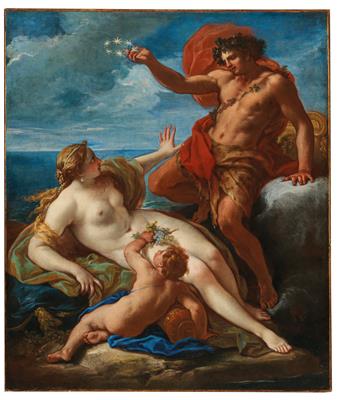Daniel Seiter
[Saleroom Notice]
(Vienna 1647–1705 Turin)
Bacchus and Ariadne,
oil on canvas, 170 x 145 cm, framed
The attribution of the present painting has changed to Daniel Seiter (Vienna 1647–1705 Turin) and is no longer as stated in the printed catalogue.
Annalisa Scarpa has revised her opinion and now endorses the attribution to Daniel Seiter for this lot.
The attribution to Daniel Seiter was suggested by Erich Schleier in 2016 (see E. Schleier, in: Studi di Storia dell’Arte, no. 27, 2016, p. 204, fig. 4).
Matthias Kunze has also independently confirmed this attribution on the basis of a photograph.
Provenance:
art market, Brussels;
where acquired by the father of the present owner, circa 1975
We are grateful to Annalisa Scarpa for suggesting the attribution of the present painting and for her help in cataloguing this lot.
This Bacchus and Ariadne is a work from the Roman period of the Veronese painter Antonio Balestra.
The mythological divinities, Bacchus and Ariadne, are shown in conversation and posed with graceful elegance; their expressions reflect the painter’s tendency to depict joyful subjects. The artist’s style displays a union between Venetian tradition and the vivacity of seventeenth century Roman painting. This picture fully expresses the properties of Balestra’s painterly style: here a lively narrative description and a sense of drama are combined with the skillfully deployed formal exuberance of Roman Seicento art, fused with the painterly colourism of Venetian tradition.
Antonio Balestra produced mythological scenes, often taking inspiration from the examples of Carlo Maratta and Marcantonio Franceschini. The cool, clear and intense colours apparent in the present painting are comparable to those in his Abduction of Europa in a private collection (see U. Ruggeri, Nuove opere documentate di Antonio Balestra, in: Pittura veneziana dal Quattrocento al Settecento: studi di storia dell’arte in onore di Egidio Martini, ed. by G. M. Pilo, Venice 1999, p. 188).
Antonio Balestra received his first training as a painter in Verona in the studio of Antonio Bellucci, subsequently moving to Venice in 1687. In 1690 he moved to Rome where he frequented the studio of Carlo Maratta whose influence would prove fundamental to the development of his personal painterly style. During the first two decades of the eighteenth century he again established himself in Venice where he attained international success painting mythological subjects. During the 1720s the artist returned to his native city of Verona and in 1725 he received notice of his election to the Accademia di San Luca in Rome (see L. Ghio, Antonio Balestra, in: I pittori Bergamaschi: il Settecento, ed by. R. Bossaglia, G. A. Dell’Acqua, Bergamo 1989, vol. 2, pp. 79-109).
Specialist: Mark MacDonnell
 Mark MacDonnell
Mark MacDonnell
+43 1 515 60 403
mark.macdonnell@dorotheum.at
08.06.2021 - 16:00
- Estimate:
-
EUR 60,000.- to EUR 80,000.-
Daniel Seiter
[Saleroom Notice](Vienna 1647–1705 Turin)
Bacchus and Ariadne,
oil on canvas, 170 x 145 cm, framed
The attribution of the present painting has changed to Daniel Seiter (Vienna 1647–1705 Turin) and is no longer as stated in the printed catalogue.
Annalisa Scarpa has revised her opinion and now endorses the attribution to Daniel Seiter for this lot.
The attribution to Daniel Seiter was suggested by Erich Schleier in 2016 (see E. Schleier, in: Studi di Storia dell’Arte, no. 27, 2016, p. 204, fig. 4).
Matthias Kunze has also independently confirmed this attribution on the basis of a photograph.
Provenance:
art market, Brussels;
where acquired by the father of the present owner, circa 1975
We are grateful to Annalisa Scarpa for suggesting the attribution of the present painting and for her help in cataloguing this lot.
This Bacchus and Ariadne is a work from the Roman period of the Veronese painter Antonio Balestra.
The mythological divinities, Bacchus and Ariadne, are shown in conversation and posed with graceful elegance; their expressions reflect the painter’s tendency to depict joyful subjects. The artist’s style displays a union between Venetian tradition and the vivacity of seventeenth century Roman painting. This picture fully expresses the properties of Balestra’s painterly style: here a lively narrative description and a sense of drama are combined with the skillfully deployed formal exuberance of Roman Seicento art, fused with the painterly colourism of Venetian tradition.
Antonio Balestra produced mythological scenes, often taking inspiration from the examples of Carlo Maratta and Marcantonio Franceschini. The cool, clear and intense colours apparent in the present painting are comparable to those in his Abduction of Europa in a private collection (see U. Ruggeri, Nuove opere documentate di Antonio Balestra, in: Pittura veneziana dal Quattrocento al Settecento: studi di storia dell’arte in onore di Egidio Martini, ed. by G. M. Pilo, Venice 1999, p. 188).
Antonio Balestra received his first training as a painter in Verona in the studio of Antonio Bellucci, subsequently moving to Venice in 1687. In 1690 he moved to Rome where he frequented the studio of Carlo Maratta whose influence would prove fundamental to the development of his personal painterly style. During the first two decades of the eighteenth century he again established himself in Venice where he attained international success painting mythological subjects. During the 1720s the artist returned to his native city of Verona and in 1725 he received notice of his election to the Accademia di San Luca in Rome (see L. Ghio, Antonio Balestra, in: I pittori Bergamaschi: il Settecento, ed by. R. Bossaglia, G. A. Dell’Acqua, Bergamo 1989, vol. 2, pp. 79-109).
Specialist: Mark MacDonnell
 Mark MacDonnell
Mark MacDonnell
+43 1 515 60 403
mark.macdonnell@dorotheum.at
|
Buyers hotline
Mon.-Fri.: 10.00am - 5.00pm
old.masters@dorotheum.at +43 1 515 60 403 |
| Auction: | Old Master Paintings I |
| Auction type: | Saleroom auction with Live Bidding |
| Date: | 08.06.2021 - 16:00 |
| Location: | Vienna | Palais Dorotheum |
| Exhibition: | 29.05. - 08.06.2021 |
